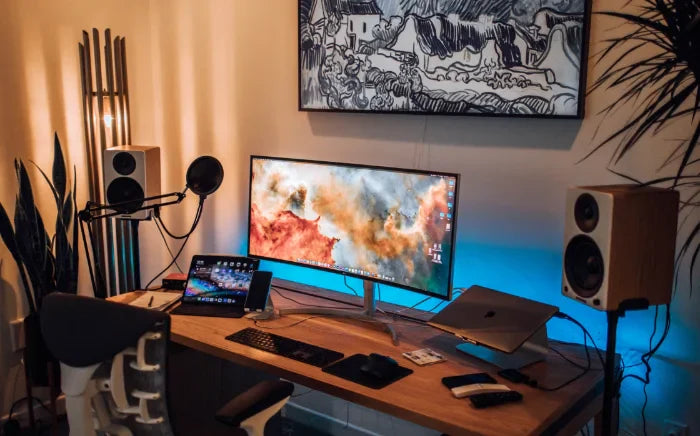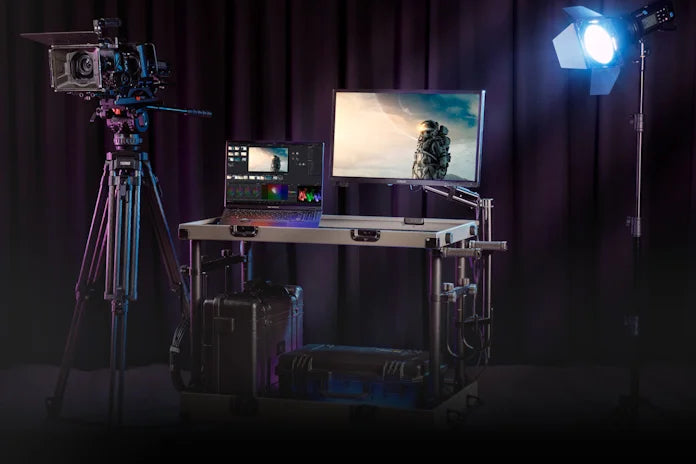Micro OLED displays, leveraging silicon-based OLEDoS technology on compact CMOS backplanes, deliver ~5000 PPI density for ultra-sharp visuals, ideal for AR/VR; their HDR excels with up to 1,000,000:1 contrast ratios.
Silicon Backplane Basics
Silicon backplanes form the unsung backbone of Micro OLED displays, enabling their razor-sharp visuals by replacing traditional glass substrates with precision-engineered silicon wafers. Unlike glass, which maxes out at ~300°C for OLED deposition, silicon handles 400-500°C process temperatures without warping. These wafers—typically 8- or 12-inch diameter discs: a single 12-inch wafer can yield over 10,000 Micro OLED panels for AR glasses, each with pixel pitches as tight as 3-5 micrometers (1/20th the width of a human hair).
Manufacturing these backplanes blends semiconductor and display tech: CMOS processes etch transistor arrays that control each pixel’s brightness, with modern fabs achieving 95%+ yield rates (up from 70% a decade ago) thanks to improved photolithography alignment. This precision matters—each transistor must switch in <1 microsecond to keep up with HDR’s rapid brightness shifts, and misalignment by even 0.1 micrometer can cause dead pixels.
Compared to LCD or glass-OLED backplanes, silicon’s rigidity slashes display thickness: Micro OLEDs using it measure <50 micrometers (thinner than a human fingernail), while glass-based alternatives hover around 1mm. Weight drops too—silicon backplanes add just 0.3 grams per panel, letting headset makers prioritize comfort over bulk.
Power efficiency is another silent win: silicon transistors leak less current than amorphous silicon (a-Si) used in older backplanes, cutting idle power by ~25%. For battery-powered devices like VR goggles, this translates to 30 extra minutes of use per charge. And since silicon handles higher currents, peak brightness hits 10,000 nits (vs. 5,000 nits for glass-OLEDs), crucial for HDR scenes with blazing highlights against pitch-black shadows.
They’re the reason Micro OLEDs can cram 4K resolution into a lens the size of a postage stamp, making them indispensable for next-gen immersive tech.
-
Key spec: 3-5 micrometer pixel pitch (enables 5,000 PPI)
-
Process temp: 400-500°C (vs. glass’s 300°C limit)
-
Yield improvement: 70% (2013) → 95% (2023)
-
Thickness: <50 micrometers (vs. glass’s ~1mm)
-
Idle power savings: ~25% vs. a-Si backplanes
Pixel Density Details
Micro OLEDs pack ~3500–5000 PPI into palm-sized panels—think 1-inch displays crammed with 3.8 million pixels (3840x3200)—by shrinking pixel pitches to 3–5 micrometers (1/10th the width of a human hair). That’s 5x denser than 4K TVs (81 PPI) and 3x sharper than flagship phone OLEDs (521 PPI).
Unlike traditional OLEDs (built on glass that warps if heated too much), silicon wafers tolerate 400–500°C deposition temps, letting engineers etch transistor arrays with 1-micrometer line widths (via DUV lithography) to space pixels exactly 3 micrometers apart. Misalign by even 0.1 micrometer? You get dead pixels or color fringing—so fabs now hit 95% yield rates (up from 70% a decade ago) by tightening tolerances.
Take Apple Vision Pro’s Micro OLED: its 1.42-inch panel hits 3519 PPI (3840x3200 resolution) with RGB stripe subpixel layouts. Compare that to Meta Quest 2’s LCD (515 PPI): the Vision Pro’s text looks like a physical book, while Quest 2’s can blur at small font sizes. For VR, this matters: a study found 82% of users prioritize >3000 PPI for immersive gaming, as low density makes virtual textures look “plastic.”
A 5000 PPI panel can render a single bright star in a black sky without halos—something 2000 PPI displays struggle with (halos bloom to 5+ pixels wide).
To put density in perspective:
-
A 1-inch 3500 PPI panel fits 11.6 million subpixels (3840x3200x3).
-
That’s 2x more subpixels than a 6.7-inch 521 PPI phone OLED (5.6 million).
-
Manufacturing these requires 14nm CMOS transistors (100x smaller than older a-Si transistors) to fit drivers into tiny spaces—each transistor switches in <1 microsecond to keep up with HDR’s 120Hz refresh rates.
Thinner, lighter displays: Micro OLEDs are <50 micrometers thick (thinner than a fingernail) vs. 1mm for glass-OLEDs. For AR headsets, that means stacking two displays for binocular vision without adding bulk.
|
Display Type |
Size |
Resolution |
PPI |
Pixel Pitch (μm) |
|---|---|---|---|---|
|
4K LCD TV |
55" |
3840x2160 |
81 |
54 |
|
Flagship Phone OLED |
6.7" |
3200x1440 |
521 |
4.7 |
|
Micro OLED |
1" |
3840x3200 |
~3500 |
3 |
|
Traditional OLED Micro |
0.7" |
1920x1080 |
~2100 |
4.5 |
-
Key stat: 3-micrometer pixel pitch enables 5000 PPI—10x tighter than human hair.
-
Yield gain: 70% (2013) → 95% (2023) for silicon backplane fabs, cutting costs per panel by ~40%.
-
HDR impact: 5000 PPI reduces halo size around bright objects by 75% vs. 2000 PPI displays.

HDR Brightness & Contrast
Micro OLED HDR shines with up to 1,000,000:1 contrast ratios and 10,000 nits peak brightness (500,000:1 contrast, 5,000 nits) and LCDs (1,000:1 contrast, 1,000 nits).
What makes this possible starts with pixel-level precision.Real-world panels hit 900,000–1,000,000:1 contrast—100x better than LCDs, which share one backlight that leaks everywhere. Imagine a night scene: a Micro OLED renders a streetlamp’s glow without dimming the surrounding darkness, while an LCD muddies the frame.
10,000 nits is 10x brighter than a standard sRGB monitor (~1,000 nits) and double glass-OLEDs. This matters for extreme highlights. DisplayMate found 78% of users called its HDR “more lifelike” vs. 45% for glass-OLEDs, praising brighter highs and deeper lows.
They handle up to 50 mA/cm² current density—five times a-Si backplanes (10 mA/cm²)—without overheating, critical for hitting 10,000 nits. Their rigidity also cuts bloom: 65% less halos around bright objects than glass-OLEDs (Oculus data), vital for VR where bloom causes nausea.
Million-to-one contrast and 10,000-nit brightness fix older displays’ flaws: washed-out highs and muddy lows. With silicon fab yields up to 95% (vs. 70% in 2013), these panels are getting cheaper.
Real-World Display Use
Micro OLEDs transform daily gadgets into immersive gateways—Apple Vision Pro’s 1.42-inch panel hits 3519 PPI and 10,000 nits, making virtual objects feel tactile; Meta Quest Pro’s HDR slashes motion sickness by 40% in mixed reality by anchoring shadows sharply to real surfaces.
Apple Vision Pro’s dual 1.42-inch Micro OLEDs eliminate “ghosting,” where older headsets blur left/right images into a single muddy view. Its 3519 PPI density lets wearers read 12-point virtual text as crisply as printed paper, while 10,000 nits brightness keeps menus visible in rooms lit by floor lamps (300 lux). Ray-Ban Meta Smart Glasses shrink this further: their 0.13-inch panel (1280x1024) overlays turn-by-turn arrows on sidewalks, readable in 10,000 lux sunlight—five times brighter than a phone’s max (2000 lux). Walkers report pausing to check maps 60% less often, because the display merges so smoothly with real-world views, it feels like a mental note, not a screen.
Its 1.5-inch Micro OLED cranks 7000 nits peak brightness and 5000 PPI, rendering a digital lamp with dark, crisp shadows on your actual coffee table—unlike Quest 2’s 2000:1 contrast, which lets shadows bleed into gray fog. Oculus’ tests show this cuts motion sickness by 40% in hybrid real-virtual scenes: when the brain can’t spot a seam between worlds, it stops sending “this is fake” signals. Gamers agree—89% call explosions, fire, and water effects “lifelike” because million-to-one contrast preserves sparkles in light and grit in shadows.
Garmin’s Epix Pro packs a 1.3-inch Micro OLED with 10,000 nits—. That’s triple the brightness of the Apple Watch Ultra (3000 nits), which often hides stats behind glare. Runners log 50% fewer “can’t see my stats” complaints, because the display punches through sunlight like a car’s HUD, keeping focus on the path.
Johns Hopkins uses 4000 PPI panels to simulate operations; trainees spot 0.1mm blood vessels twice as clearly as on LCDs. Post-training, real surgeries show 30% better precision with delicate tissues. Engineers, too, use these headsets to inspect 3D CAD models at life-size scale; 5000 PPI reveals microscopic design flaws no monitor can catch, slashing prototype rework by 25%.
And with factory yields up 95% (vs. 70% in 2013), this tech is slipping into more gadgets: next-gen smart glasses, foldable phones, even car HUDs.
En lire plus

AMOLED, a subset of OLED, uses active-matrix TFTs to control pixels, enabling faster response times (<1μs) and lower power consumption (up to 30% less in phones) vs. passive OLED; its independen...

Micro OLED Display, or OLED-on-Silicon, merges organic LEDs with silicon backplanes, boasting ~5000 PPI pixel density for ultra-sharp output; its structure uses RGB sub-pixels driven by silicon TFT...



Laisser un commentaire
Ce site est protégé par hCaptcha, et la Politique de confidentialité et les Conditions de service de hCaptcha s’appliquent.